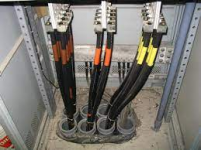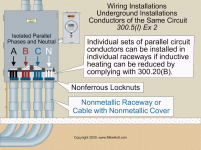I have never done this, however I have seen other electricians do this and it cause harmonic issues, voltage imbalance and fires.
Example: Installing all of A phase conductors in one conduit, B phase conductors in a second conduit and C phase conductors in a third for a parallel circuit. When I install any parallel circuit (generally a service entrance) I install all phase conductors and the neutral in each individual riser conduit. I don't think the power company would hook it up otherwise.
Another example: A friend installed a panel in his garage. It was a 100amp sub panel fed from the "mobile home" panel located on his meter pole. when he penetrated the panel he ran each phase conductor and the neutral and ground through four separate knockouts in the panel. This caused a voltage imbalance and it began heating up the 100 amp enclosure. He had unintentionally set up an induction heater. I corrected the issue by running them all through a single 2" knockout and all was fine. I have worked house fires where the service caught fire for the same situation (according to the cause and origin investigator).
If we run a ground from a service in EMT to the ground rod, we are required to install a bonding bushing on the EMT fitting in the panel for the same reason.
I used to be an electrician/mechanic in an industrial facility, we used bearing heaters to heat bearings to get them to slip onto a shaft easier, it's same principal except the conductor is a series of wraps that close around the bearing.
So this was my real life situation last week. Installing a temporary power generator, 400 amp distribution panel with 4 100 amp 480 volt breakers feeding four large temporary air conditioners. The equipment was designed to install female cam-lock tails on the breakers and run them all through one large opening that was shielded from water intrusion by a rubber flap (you see this on large trailer mounted generators). The city electrical inspector wouldn't allow the large hole to serve as a proper penetration and required us to install cord grip fittings as a strain relief. The wire was single conductor 1/0 SOOW (like welding leads). I raised the question about running a single conductor through one hole in a metal enclosure. We ended up doing what the inspector required, however I cut a large Teflon plate to fit the large opening and drilled out the Teflon plate to accommodate the fittings. I was still worried about the fittings heating up, but they didn't. I spray painted the Teflon grey to match the enclosure.
The result was that we passed the inspection, but the city inspector didn't really examine the plate closely. If he knew that it was Teflon, he might have raised a question or failed it.
Upon further examination of the generators, I noticed that the individual phase, cam-lock receptacles (factory installed) on the generator are mounted in a metal panel that is bonded to the frame and ultimately grounded to a ground rod. These don't heat up, cause a voltage imbalance or harmonic issues. Here lies my question, what am I missing? Why doesn't this cause problems when I have seen the same principal cause issues in other situations?
I've been an electrician for 32 years and a Master for 20, I don't know it all and I have to seek advice/answers when I run into an odd situation.
Example: Installing all of A phase conductors in one conduit, B phase conductors in a second conduit and C phase conductors in a third for a parallel circuit. When I install any parallel circuit (generally a service entrance) I install all phase conductors and the neutral in each individual riser conduit. I don't think the power company would hook it up otherwise.
Another example: A friend installed a panel in his garage. It was a 100amp sub panel fed from the "mobile home" panel located on his meter pole. when he penetrated the panel he ran each phase conductor and the neutral and ground through four separate knockouts in the panel. This caused a voltage imbalance and it began heating up the 100 amp enclosure. He had unintentionally set up an induction heater. I corrected the issue by running them all through a single 2" knockout and all was fine. I have worked house fires where the service caught fire for the same situation (according to the cause and origin investigator).
If we run a ground from a service in EMT to the ground rod, we are required to install a bonding bushing on the EMT fitting in the panel for the same reason.
I used to be an electrician/mechanic in an industrial facility, we used bearing heaters to heat bearings to get them to slip onto a shaft easier, it's same principal except the conductor is a series of wraps that close around the bearing.
So this was my real life situation last week. Installing a temporary power generator, 400 amp distribution panel with 4 100 amp 480 volt breakers feeding four large temporary air conditioners. The equipment was designed to install female cam-lock tails on the breakers and run them all through one large opening that was shielded from water intrusion by a rubber flap (you see this on large trailer mounted generators). The city electrical inspector wouldn't allow the large hole to serve as a proper penetration and required us to install cord grip fittings as a strain relief. The wire was single conductor 1/0 SOOW (like welding leads). I raised the question about running a single conductor through one hole in a metal enclosure. We ended up doing what the inspector required, however I cut a large Teflon plate to fit the large opening and drilled out the Teflon plate to accommodate the fittings. I was still worried about the fittings heating up, but they didn't. I spray painted the Teflon grey to match the enclosure.
The result was that we passed the inspection, but the city inspector didn't really examine the plate closely. If he knew that it was Teflon, he might have raised a question or failed it.
Upon further examination of the generators, I noticed that the individual phase, cam-lock receptacles (factory installed) on the generator are mounted in a metal panel that is bonded to the frame and ultimately grounded to a ground rod. These don't heat up, cause a voltage imbalance or harmonic issues. Here lies my question, what am I missing? Why doesn't this cause problems when I have seen the same principal cause issues in other situations?
I've been an electrician for 32 years and a Master for 20, I don't know it all and I have to seek advice/answers when I run into an odd situation.



